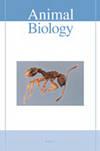An investigation on cauda storage of sperm in hamster epididymis
IF 0.9
4区 生物学
Q2 ZOOLOGY
引用次数: 0
Abstract
Immature testicular sperm of mammals acquire the potential to move in a forward direction during their journey through excurrent ducts, efferent ductules and the epididymis. The present study aimed to determine the sperm storage time using the hamster cauda epididymis. Ligation of the left epididymal tubule at the junction between the distal corpus and the proximal cauda was carried out to determine the storage time. The right epididymis was left unaltered as the control. On days 3, 12, 15, 24, 28, 32, and 40 after ligation of the cauda, experiments were carried out and repeated five times. Sperm total count and mortality were determined using the haemocytometer counting method and sperm viability was assessed with the live/dead viability kit. The morphology of cauda sperm was observed by preparing sperm smears from each animal. Data were analyzed using SPSS and all values were expressed as mean ± SEM. On day 40, the total number of cauda sperms was reduced remarkably. In the experimental groups and in the control, 3–6% of sperm motility was maintained until day 40. By day 3, the percentage of live sperm was 50% and by the 40th day, it was decreased up to 10%. In the control group, the live sperm percentage was 24% by the 40th day (). By day 32, 76% of the cauda spermatozoa appeared abnormal with head defects, mid piece and neck defects and multiple defects. Findings of the present study indicate that cauda sperm storage time is more than 40 days. Motility, viability and morphology of these spermatozoa were decreased remarkably during this storage time.仓鼠附睾精子尾状贮存的研究
哺乳动物的未成熟睾丸精子在通过流出管、传出管和附睾的过程中获得了向前移动的潜力。本研究旨在利用仓鼠附睾尾来确定精子的储存时间。结扎位于远端主体和近端尾状体交界处的左侧附睾小管,以确定储存时间。作为对照,右侧附睾保持不变。在尾状结扎后的第3、12、15、24、28、32和40天,进行实验并重复5次。使用血细胞仪计数方法测定精子总数和死亡率,并使用活/死活力试剂盒评估精子活力。通过制备每只动物的精子涂片来观察尾状精子的形态。数据用SPSS统计软件进行分析,所有数值均以平均值±SEM表示。第40天,尾状精子总数显著减少。在实验组和对照组中,3-6%的精子活力一直维持到第40天。到第3天,活精子的百分比为50%,到第40天,它下降到10%。在对照组中,到第40天,活精子百分比为24%()。到第32天,76%的尾状精子出现异常,包括头部缺陷、中段和颈部缺陷以及多个缺陷。目前的研究结果表明,尾状精子的储存时间超过40天。这些精子的活力、活力和形态在储存期间显著降低。
本文章由计算机程序翻译,如有差异,请以英文原文为准。
求助全文
约1分钟内获得全文
求助全文
来源期刊

Animal Biology
生物-动物学
CiteScore
2.10
自引率
0.00%
发文量
34
审稿时长
3 months
期刊介绍:
Animal Biology publishes high quality papers and focuses on integration of the various disciplines within the broad field of zoology. These disciplines include behaviour, developmental biology, ecology, endocrinology, evolutionary biology, genomics, morphology, neurobiology, physiology, systematics and theoretical biology. Purely descriptive papers will not be considered for publication.
Animal Biology is the official journal of the Royal Dutch Zoological Society since its foundation in 1872. The journal was initially called Archives Néerlandaises de Zoologie, which was changed in 1952 to Netherlands Journal of Zoology, the current name was established in 2003.
 求助内容:
求助内容: 应助结果提醒方式:
应助结果提醒方式:


